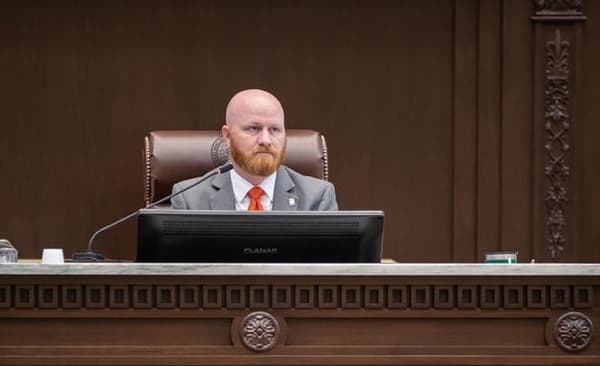
Law & Principles
Lawsuit reform advances, could limit ‘jackpot’ awards
Ray Carter | May 22, 2025
The threat of “jackpot” lawsuit awards for “noneconomic” damages could be reduced under legislation advanced by the Oklahoma Senate.
Senate Bill 453, by state Sen. Brent Howard, would cap awards for vague “noneconomic” losses for bodily injury claims at $500,000. For permanent and severe personal bodily injuries, the bill imposes no cap. And for a permanent mental injury that prevents a plaintiff from being employed or enjoying a reasonable standard of living, the cap is $1 million.
The legislation does not cap true economic damages, which include payments for lost wages, medical expenses, and any ongoing treatment. Also, under the bill, there would be no cap on noneconomic damages in cases where an injury is the result of another individual’s gross negligence, fraud, or intentional/malicious action.
The legislation also allows lawsuits with a monetary relief request of $250,000 or less to receive an expedited process.
Howard, R-Altus, said the legislation will provide financial certainty to all Oklahomans while still allowing injured parties to be made financially whole, saying the legislation makes certain that “not everybody is worried about losing every bit of property that they’ve ever saved for their own retirement, for their own benefit, in case they have a simple mess up at some time.”
Because large awards for unquantified noneconomic damages have been shown to drive businesses away from states and hinder job creation and economic growth, Oklahoma lawmakers have sought to provide legal certainty by imposing caps on noneconomic damages.
In 2011, Oklahoma legislators voted to impose a $350,000 cap on awards for noneconomic damages in many cases.
“What we’re looking at with this language is trying to just get some certainty across the state as to what victims can recover.” —State Sen. Brent Howard (R-Altus)
However, in a bizarre 2019 ruling, the Oklahoma Supreme Court struck down that law, declaring it a “special law” since the cap would apply in cases “where the plaintiff survives the injury-causing event, while persons who die from the injury-causing event face no such limitation.”
The plaintiff in that case received $9.7 million in payment for an on-the-job accident that cost him part of his arm, but wanted millions more in additional “noneconomic” damages.
Only one current member of the Oklahoma Supreme Court was among the majority that struck down the noneconomic-damages cap in 2019, and lawmakers believe the current court may take a different view of caps if and when the issue reaches them again.
“The Economic and Fiscal Impact of Excessive Tort Costs on Oklahoma,” a study commissioned by the State Chamber Research Foundation and conducted by the Perryman Group, found that excessive tort costs have translated into the loss of $3.7 billion in state gross product each year and almost 32,000 jobs in Oklahoma.
The report found the associated decrease in tax receipts includes $195 million annually to the state and $162.5 million to local government entities.
The State Chamber Research Foundation study estimated that the share of state economic losses tied to the Oklahoma Supreme Court’s 2019 decision totaled nearly $2.7 billion in gross product from 2020 to 2023.
Opponents objected to placing any cap on any lawsuit awards.
“Why should the Legislature place an arbitrary dollar value on human suffering, especially when juries, who are the finders of fact made up of Oklahomans, are fully capable of weighing evidence and deciding damages?” asked state Sen. Michael Brooks, D-Oklahoma City.
Howard noted that caps are effectively in place for many injured parties because they will never receive a dime of payment. Only those who sue wealthy individuals or businesses currently receive awards, at least in practice.
“You can have the most sympathetic victim that is ever out there with the most significant trauma that anybody could imagine, but if the perpetrator was somebody that just had no money, that victim—regardless of not having a cap—effectively has a practical cap of ever being able to recover (more than) zero,” Howard said. “What we’re looking at with this language is trying to just get some certainty across the state as to what victims can recover.”
Eight other states cap noneconomic damages, and 26 states cap noneconomic damages in medical malpractice cases.
SB 453 passed the Oklahoma Senate on a 37-8 vote that broke along party lines, with Republicans in support and Democrats opposed. Trial lawyers, who typically receive one-third or more of any major award granted in a lawsuit, have long been major donors to the Democratic Party.
The Oklahoma House of Representatives took up the bill a few hours later and passed it without debate on a 61-19 vote.
The bill now proceeds to the governor.
NOTE: This story has been updated since publication to include information about the vote in the Oklahoma House of Representatives.

Ray Carter
Director, Center for Independent Journalism
Ray Carter is the director of OCPA’s Center for Independent Journalism. He has two decades of experience in journalism and communications. He previously served as senior Capitol reporter for The Journal Record, media director for the Oklahoma House of Representatives, and chief editorial writer at The Oklahoman. As a reporter for The Journal Record, Carter received 12 Carl Rogan Awards in four years—including awards for investigative reporting, general news reporting, feature writing, spot news reporting, business reporting, and sports reporting. While at The Oklahoman, he was the recipient of several awards, including first place in the editorial writing category of the Associated Press/Oklahoma News Executives Carl Rogan Memorial News Excellence Competition for an editorial on the history of racism in the Oklahoma legislature.